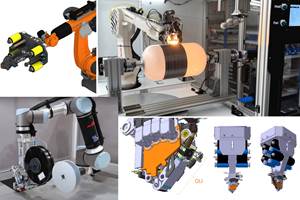Composites, plastics injection molding generates highly visual parts
CAMX 2024: ColorForm and long fiber injection (LFI) technologies by KraussMaffei support automotive, consumer and other end markets in their quest for high-performance, lightweight parts with aesthetic qualities.
Share
ColorForm process. Source | KraussMaffei
KraussMaffei (Munich, Germany and Hebron, Ky., U.S.) highlights various technologies and equipment for thermoset — mainly polyurethane (PUR)-based — plastics processing that are capable of generating visually aesthetic part surfaces. Serving customers in automotive interior trim and seating, refrigeration insulation as well as other lightweight applications, the company has experience with short- and continuous fiber-reinforced thermoset or reactive thermoplastic parts production.
Rooted in clear coat molding (CCM) technology, ColorForm, based on the principle of multi-component injection molding, generates high-quality cosmetic parts in a two-step process. First, an injection molded substrate is created, following by overmolding of the substrate with a PUR system. After curing and demolding, the part is ready for assembly e.g., for car interiors or — an application that is relatively new to ColorForm — relatively large vehicle exteriors that may even include self-healing surface properties.
KraussMaffei is also capable of achieving high-quality surfaces (surface coloring, gloss, smoothness and durability) for fiber composite parts, mainly focusing on agricultural or transportation vehicles, through a long fiber injection (LFI) process. Here, chopped glass fiber is embedded in a PUR matrix for weight reduction and reinforcement purposes. In order to combine this with high surface quality, there are two options: (1) the fiber-matrix mix is applied to a thermoplastic, deep-drawn film prior to curing, or (2) a spray paint and barrier coat is overmolded with the fiber-matrix mix, that provides the desired mechanical properties.
Related Content
-
Industrializing additive manufacturing in the defense/aerospace sector
GA-ASI demonstrates a path forward for the use of additive technologies for composite tooling, flight-qualified parts.
-
The next evolution in AFP
Automated fiber placement develops into more compact, flexible, modular and digitized systems with multi-material and process capabilities.
-
Reinforcing hollow, 3D printed parts with continuous fiber composites
Spanish startup Reinforce3D’s continuous fiber injection process (CFIP) involves injection of fibers and liquid resin into hollow parts made from any material. Potential applications include sporting goods, aerospace and automotive components, and more.
Related Content
Industrializing additive manufacturing in the defense/aerospace sector
GA-ASI demonstrates a path forward for the use of additive technologies for composite tooling, flight-qualified parts.
Read MoreThe next evolution in AFP
Automated fiber placement develops into more compact, flexible, modular and digitized systems with multi-material and process capabilities.
Read MoreReinforcing hollow, 3D printed parts with continuous fiber composites
Spanish startup Reinforce3D’s continuous fiber injection process (CFIP) involves injection of fibers and liquid resin into hollow parts made from any material. Potential applications include sporting goods, aerospace and automotive components, and more.
Read MoreComposites end markets: New space (2025)
Composite materials — with their unmatched strength-to-weight ratio, durability in extreme environments and design versatility — are at the heart of innovations in satellites, propulsion systems and lunar exploration vehicles, propelling the space economy toward a $1.8 trillion future.
Read MoreRead Next
Elastomer-integrated composite grows high-temperature application options
CAMX 2024: Rishon, which combines RCF Technologies’ elastomer and composite fabrics, bonds to metals and most composites, while providing high-temperature operations, sound and vibration absorption, heat insulation and more.
Read MoreNext-gen fan blades: Hybrid twin RTM, printed sensors, laser shock disassembly
MORPHO project demonstrates blade with 20% faster RTM cure cycle, uses AI-based monitoring for improved maintenance/life cycle management and proves laser shock disassembly for recycling.
Read MoreUltrasonic welding for in-space manufacturing of CFRTP
Agile Ultrasonics and NASA trial robotic-compatible carbon fiber-reinforced thermoplastic ultrasonic welding technology for space structures.
Read More






